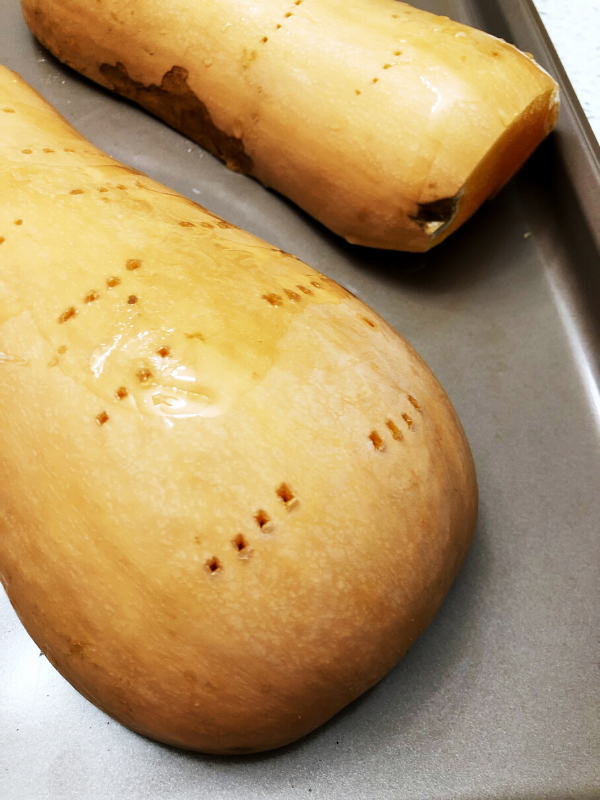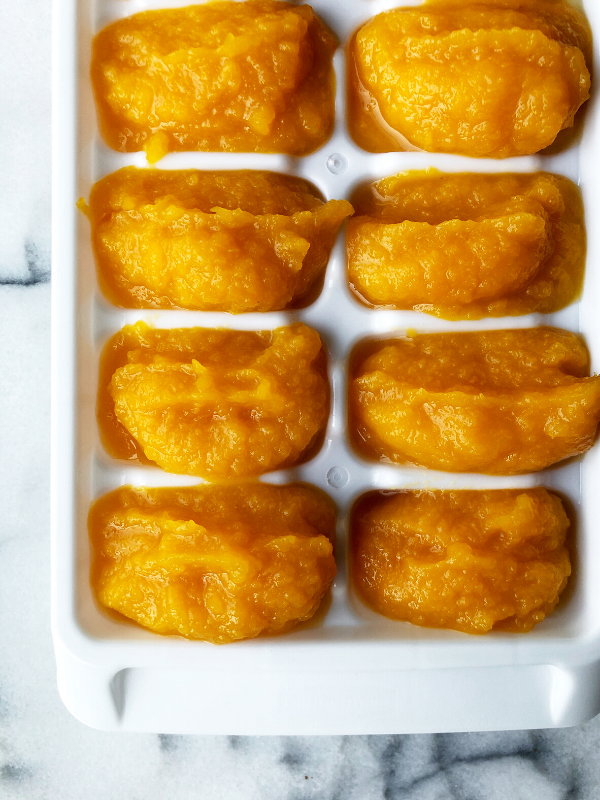Hello Friends! Let’s make Homemade Baby Food Butternut Squash together. When it came to feeding my babies, I always knew I wanted to make my own homemade baby food. It’s easy to make, only needs a few basic ingredients, and it freezes well! It is great for meal prep. Plus, in my opinion, they taste so much better than store-bought baby food.

I know, there are probably a lot of questions running through your head right now mama. I can totally relate. I have been there with two of my baby girls, both times wonderful, hard and so different. I am not claiming to be an expert by any means, I am just a mama, wanting to share some tips and tricks I have learned during this journey called motherhood.
When to introduce solid foods?
There are a lot of opinions about this topic. Let me say one thing – “YOU DO YOU MAMA!” Whatever you choose for your baby is best for your baby. If you decide to exclusively breast feed, formula feed or do a combination of both, remember, you are doing great. You will never hear any judgment from me! The same applies for the solid foods.
The general opinions suggest that breast fed babies can start with solid foods (baby cereal or baby puree) when they turn 6 months and formula fed babies can start solid foods (baby cereal or baby puree).
In my opinion, the best time is to start between 5-6 months because the baby’s digestive system is able to tolerate new foods. Baby should be showing signs of interest in food such as watching you when eating or the amount of breast milk or formula do not seem to be enough – baby keeps crying after each feed and/or requires more frequent feeds.
Some general guidelines about when to start with baby food:
- Baby requires more frequent feeds, more than 8-12x in 24-hour period (breast fed babies)
- Baby is still hungry even after drinking more than 32 oz in 24-hour period (formula fed babies)
- Baby has a very good head support
- Baby is able to sit with your support
- Baby is interested in what you and the rest of the family eat
What should I feed my baby?
It’s recommended that you start with veggie-based baby food or baby cereal such as rice cereal. You always want to introduce one type of food first, for example butternut squash, and after 2-4 days you can introduce another. This way, you can really stay on top of any allergic reactions (rash, diarrhea) your baby can have to a new food.
With both of my girls, I started with the following foods – butternut squash, avocado, sweet potatoes and baby rice cereal and they both did great.
Important things to keep in mind when starting solid foods
- Be patient and try not to get frustrated. It’s easier said than done, I know. But it’s important to stay calm.
- Use a small baby spoon when feeding your baby and start with a very small portion. Place the spoon towards the baby’s mouth and encourage the baby to lick the spoon. You can also gently move the spoon inside baby’s mouth
- You want to make sure that baby can see the food
- Even 1-2 “bites” is a success and don’t worry if the baby spits the food out at first. Don’t give up and offer the same food next day
- If the baby refuses the new food at first, don’t worry. Wait a few days and offer again. I have learned with my girls that exposure and repetition is key

How to make baby food butternut squash
What kind of butternut squash should I use?
Should I use an organic or regular butternut squash? Well, if you can afford organic, go with organic. If you buy non-organic, it’s perfectly fine too in my opinion.
How should I cook baby food butternut squash?
There are several ways you can cook baby food butternut squash such as steaming, roasting, simmering or boiling. My absolute favorite is roasting because the veggies retain a greater amount of nutrients and also tastes so much better as it brings out its natural sweetness than the other 3 methods. But again, “YOU DO YOU MAMA!” After you roast your butternut squash, let it completely cool down and puree the baby using a food processor or smoothie maker until silky smooth.




How should I store or meal-prep baby food butternut squash?
The homemade baby food butternut squash lasts up to 3 days in the fridge or up to 3 months in a freezer. I like to use glass food containers to store my baby food in the fridge. I also use ice cube trays to store baby food in a freezer. I simply fill out the tray with the homemade baby food butternut squash and freeze it until firm. Then I pop all cubes out and store it in a separate Ziplock bag or stasher bag in a freezer labeled accordingly with a type of baby food and date.

How do I reheat the homemade baby food butternut squash?
Simply warm fresh baby food in the microwave to a desired temperature or serve it at room temperature depending on what your baby likes. To defrost previously frozen baby food, you can either leave it to defrost overnight in a fridge or simply warm frozen baby food cubes in a microwave. I usually start with 30 seconds, then stir and warm for another 30 seconds. Stir and check the temperature to make sure the food is not too hot and then feed your baby.


Homemade Baby Food Butternut Squash
Homemade Baby Food Butternut squash is so easy to make, only
contains two basic ingredients and it’s so much better than store bought baby food. Plus, it freezes well and it’s great for meal prep.
Ingredients
- 1 medium size butternut squash
- 1 tsp avocado or olive oil
- 2-4 oz filtered water
Instructions
- Preheat oven to 375 degrees F.
- Cut butternut squash lengthwise and using a spoon, scoop out
all the seeds. Using a fork, pierce holes into the butternut squash and spray some oil on top of the “meat” part. - Turn butternut squash “meat” down and bake for 45 min or
until soft and let it cool off completely. - Using a spoon, scoop out the cooked “meat” into a food
processor and puree until silky smooth. Add water to make it to the right
consistency for your baby. More water makes the baby food butternut squash thinner and less water makes the baby food butternut squash thicker.





Leave a Reply